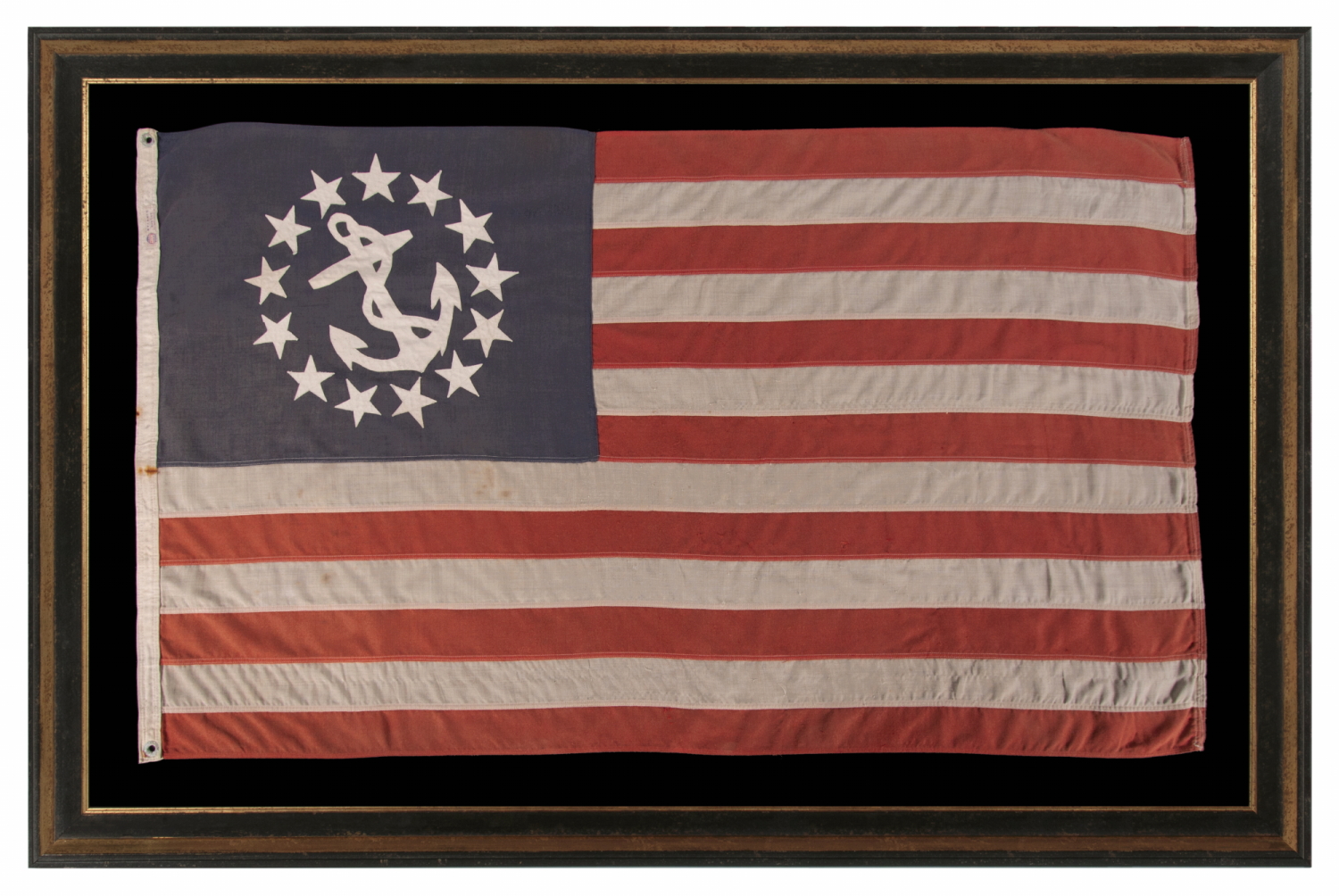
| |
ANTIQUE AMERICAN PRIVATE YACHT FLAG (ENSIGN) WITH 13 STARS SURROUNDING A CANTED ANCHOR, MADE BY THE ANNIN COMPANY OF NEW YORK & NEW JERSEY, CIRCA 1945-1950’s |
|
| Available: |
Sold |
| Frame Size (H x L): |
Approx. 48' x 73.5" |
| Flag Size (H x L): |
35.75" x 61.5" |
|
| Description....: |
|
The medallion configuration, 13-star, 13-stripe flag with a canted center anchor was entered into official use in 1848, following an act of Congress, that made it the official signal for U.S. pleasure sailing vessels. The need for such a flag arose with the popularity of boating as a pastime for well-to-do Americans, and as a competitive sport, in addition to its longstanding utilitarian role as a vehicle of trade. In early America, all boats were subject to customs searches at every port. Without modern income tax, the federal government derived its revenues mostly from tariffs, so an accounting of foreign goods on ships was a critical venture. As yachting for pleasure became more prevalent, however, more and more time was spent searching boats that had no such inventory, wasting time for both customs officials and wealthy ship owners.
John Cox Stevens (1775 - 1857), one of the most important members of New York society, was responsible for bringing this flag to fruition. Stevens was the paternal grandson of John Stevens Jr., New Jersey delegate to the Second Continental Congress, and the son of Revolutionary War officer, Colonel John Stevens, a pioneer in the development of steamboats and purchaser of what is now the City of Hoboken. Among other ventures, John Cox Stevens served as president of the Jockey Club (United Kingdom), was a founding member and 2nd president of New York's Union Club (est. 1836), and founding Commandant of the New York Yacht Club (elected 1844/est. 1845). He was part of the syndicate that own the yacht "America," which, in 1851, won the trophy that would eventually be named in its honor, the America's Cup.
In 1847, Stevens approached the secretary of the treasury and suggested that something be done to streamline the customs process for non-trade vessels. In 1848, legislation passed Congress requiring registration of these boats, which could then fly the “American Yachting Signal” to bypass customs. This remained on the books until the 1980’s. Though the 1848 legislation was revoked, flags in this design, flown for decorative function, continues to this day.
The stars and anchor are made of cotton and are double-appliquéd (applied to both sides) with a zigzag machine stitch. This type of stitch was patented for use on flags in 1892, quickly became the most common way to appliqué stars, and remained so until after WWII (U.S. involvement 1941-45). The canton and the stripes of the flag are made of a blended wool and nylon bunting, that has been pieced with machine stitching. There us a sailcloth canvas binding along the hoist, with two white metal grommets. Near the top of this, on the obverse, is an Annin makers’ tag that reads: “The Name Annin Guarantees Quality; Nylanin Bunting; Reg U.S. Pat Off; Nylon 75% - Wool 25%; 2 Ply Warp – 2 Ply Filling.” Annin is our nation’s eldest flag-maker that is still in business today. The company was founded in the 1830's, incorporated in 1847, and was located in New York until the 1960’s, when it moved to New Jersey. This particular example was likely made between the latter half of the 1940’s and the 1950’s.
13 star flags have been flown throughout our nation’s history for a variety of purposes. In addition to their use on private yachts, they were hoisted at patriotic events, including Lafayette’s final visit in 1824-25, the celebration of the nation’s centennial in 1876, and the sesquicentennial in 1926. They were displayed during the Civil War, to reference past struggles for American liberty and victory over oppression, and were used by 19th century politicians while campaigning for the same reason. The U.S. Navy used the 13 star count on small boats until 1916, because it was easier to discern fewer stars at a distance on a small flag. Commercial flag-makers mirrored this practice and some private ships flew 13 star flags during the same period as the Navy.
Mounting: The flag was mounted and framed within our own textile conservation department, which is led by expert trained staff. We take great care in the mounting and preservation of flags and have framed thousands of examples. The background is 100% cotton twill, black in color, that was washed and treated for color fastness. The mount was placed in a black-painted, hand-gilded and distressed Italian molding. The glazing is U.V. protective plexiglass.
Condition: There is modest to moderate fading in the blue canton and red stripes. There are moderate rust stains along the hoist binding, near the center, accompanied by more minor stains of the same sort in the 4th and 5th white stripes, beneath the canton. Many of my clients prefer early and vintage flags to show their age and history of use. |
|
|
|
| Collector Level: |
Beginners and Holiday Gift Giving |
|
| Flag Type: |
Sewn flag |
|
| Star Count: |
13 |
|
| Earliest Date of Origin: |
1945 |
|
| Latest Date of Origin: |
1959 |
|
| State/Affiliation: |
13 Original Colonies |
|
| War Association: |
|
|
| Price: |
SOLD |
|
| |
Views: 2047 |
|
|
|

